The Gupta Empire was an ancient Indian empire on the Indian subcontinent which existed from the early 4th century CE to early 6th century CE. At its zenith, from approximately 319 to 467 CE, it covered much of the Indian subcontinent. This period has been considered as the Golden Age of India by historians, although this characterisation has been disputed by some other historians. The ruling dynasty of the empire was founded by Gupta and the most notable rulers of the dynasty were Chandragupta I, Samudragupta, Chandragupta II, Kumaragupta I and Skandagupta.

Chandragupta II, also known by his title Vikramaditya, as well as Chandragupta Vikramaditya, was the third ruler of the Gupta Empire in India. Modern scholars generally identify him with King Chandra of the Delhi iron pillar inscription.

Kālidāsa was a Classical Sanskrit author who is often considered ancient India's greatest poet and playwright. His plays and poetry are primarily based on Hindu Puranas and philosophy. His surviving works consist of three plays, two epic poems and two shorter poems.
Nauratan/Navaratnas or Nauratan was a term applied to a group of nine extraordinary people in an emperor's court in India. The well-known Navaratnas include the ones in the courts of the legendary emperor Vikramaditya, the 16th-century Mughal emperor Akbar, and the 18th-century feudal lord Raja Krishnachandra.

Vikramaditya II was the son of King Vijayaditya and ascended the Badami Chalukya throne following the death of his father. This information comes from the Lakshmeshwar inscriptions in Kannada dated 13 January 735 A.D. From inscriptions it has come to be known that even before his coronation, Vikramaditya II, as a crown prince (Yuvaraja), had conducted successful military campaigns against their arch enemy, the Pallavas of Kanchipuram. His most important achievements were the capture of Kanchipuram on three occasions, the first time as a crown prince, the second time as an emperor and the third time under the leadership of his son and crown prince Kirtivarman II. This is attested to by another Kannada inscription, known as the Virupaksha Temple inscription which alludes to the emperor as the conqueror of Kanchi on three occasions and reads Sri Vikramaditya-bhatarar-mume-Kanchiyan-mume parajisidor. The other notable achievement was the consecration of the famous Virupaksha Temple and Mallikarjuna Temple by his queens Lokadevi and Trilokadevi at Pattadakal. These two monuments are the centre piece of the UNESCO World Heritage Monuments at Pattadakal. Vikramaditya II was a powerful ruler and was in power for 40 years. In order to maintain peace he entered into marriage alliance with Rashtrakutas.

A vetala is a class of beings in Hindu mythology. They are usually defined as a knowledgeable paranormal entity said to be dwelling at charnel grounds. Reanimated corpses are used as vehicles by these spirits for movement. A vetala may possess and leave a dead body at will.
Vikram Samvat, also known as the Vikrami calendar is a Hindu calendar historically used in the Indian subcontinent and still used in several states. It is a solar calendar, using twelve to thirteen lunar months each solar sidereal years. The year count of the Vikram Samvat calendar is usually 57 years ahead of the Gregorian calendar, except during January to April, when it is ahead by 56 years.

The Shaka era is a historical Hindu calendar era, the epoch of which corresponds to Julian year 78.

INS Vikramaditya is a modified Kiev-class aircraft carrier and the flagship of the Indian Navy. The carrier entered into service in 2013.
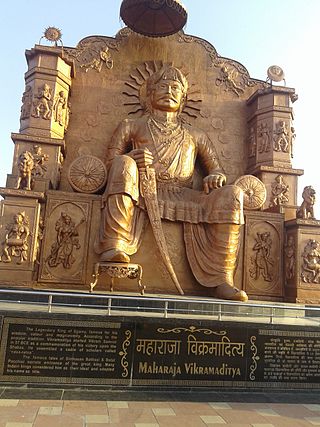
Vikramaditya was a legendary king mentioned in ancient Indian literature, featuring in traditional stories including those in Vetala Panchavimshati and Singhasan Battisi. Many describe him as ruler with his capital at Ujjain. "Vikramaditya" was also a common title adopted by several monarchs in ancient and medieval India, and the Vikramaditya legends may be embellished accounts of different kings. According to popular tradition, Vikramaditya began the Vikrama Samvat era in 57 BCE after defeating the Shakas, and those who believe that he is based on a historical figure place him around the first century BCE. However, this era is identified as "Vikrama Samvat" after the ninth century CE.

Vikramaditya VI became the Western Chalukya King after deposing his elder brother Someshvara II, a political move he made by gaining the support of Chalukya vassals during the Chola invasion of Chalukya territory. Vikramaditya's reign is marked with the abolishment of the Saka era and the start of the Chalukya-Vikrama era. He was the greatest of the Western Chalukya kings and had the longest reign in the dynasty. He earned the title Permadideva and Tribhuvanamalla. He had several queens who ably assisted him in administration. One of his queens, Chandala Devi, a princess from the Shilahara ruling family of Karad was called Abhinava Saraswati for her skills as an artist. Queen Kethala Devi administered the Siruguppa region and Savala Devi was in charge of an Agrahara in Naregal. According to the historian Kamath, Vikramaditya VI was a "great king who ruled over South India" and he finds a "pride of place in Karnataka history". More inscriptions in Kannada are attributed to Vikramaditya VI than any other king prior to the Vijayanagara era.
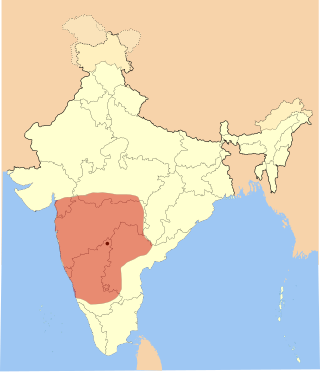
The Western Chalukya Empire ruled most of the western Deccan, South India, between the 10th and 12th centuries. This Kannada-speaking dynasty is sometimes called the Kalyani Chalukya after its regal capital at Kalyani, today's Basavakalyan in the modern Bidar district of Karnataka state, and alternatively the Later Chalukya from its theoretical relationship to the 6th-century Chalukya dynasty of Badami. The dynasty is called Western Chalukyas to differentiate from the contemporaneous Eastern Chalukyas of Vengi, a separate dynasty. Before the rise of these Chalukyas, the Rashtrakuta Empire of Manyakheta controlled most of the Deccan Plateau and Central India for over two centuries. In 973, seeing confusion in the Rashtrakuta empire after a successful invasion of their capital by the ruler of the Paramara dynasty of Malwa, Tailapa II, a feudatory of the Rashtrakuta dynasty ruling from Bijapur region defeated his overlords and made Manyakheta his capital. The dynasty quickly rose to power and grew into an empire under Someshvara I who moved the capital to Kalyani.
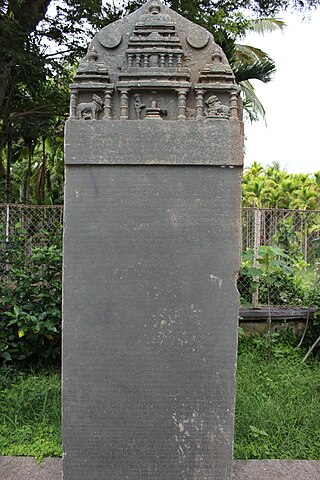
Someshvara III was a Western Chalukya king, the son and successor of Vikramaditya VI. He ascended the throne of the Western Chalukya Kingdom in 1126 CE, or 1127 CE.

Singhasan Battisi is a collection of Indian folk tales. The title literally means "thirty-two (tales) of the throne". In the frame story, the 11th century king Bhoja discovers the throne of the legendary ancient king Vikramaditya. The throne has 32 statues, who are actually apsaras that had been turned into stone due to a curse. Each of the apsaras tells Bhoja a story about the life and adventures of Vikramaditya, in order to convince him that he is not deserving of Vikramaditya's throne.
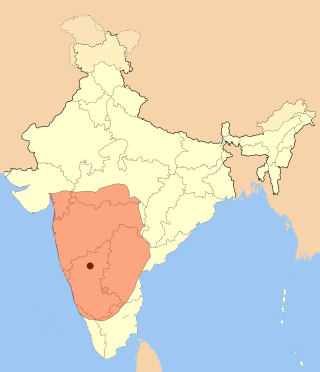
The Chalukya dynasty was a Classical Indian dynasty that ruled large parts of southern and central India between the 6th and the 12th centuries. During this period, they ruled as three related yet individual dynasties. The earliest dynasty, known as the "Badami Chalukyas", ruled from Vatapi from the middle of the 6th century. The Badami Chalukyas began to assert their independence at the decline of the Kadamba kingdom of Banavasi and rapidly rose to prominence during the reign of Pulakeshin II. After the death of Pulakeshin II, the Eastern Chalukyas became an independent kingdom in the eastern Deccan. They ruled from Vengi until about the 11th century. In the western Deccan, the rise of the Rashtrakutas in the middle of the 8th century eclipsed the Chalukyas of Badami before being revived by their descendants, the Western Chalukyas, in the late 10th century. These Western Chalukyas ruled from Kalyani until the end of the 12th century.
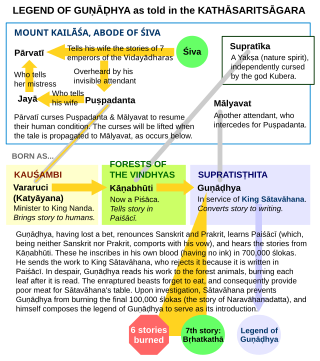
Guṇāḍhya is the Sanskrit name of the sixth-century Indian author of the Bṛhatkathā, a large collection of tales attested by Daṇḍin, the author of the Kavyadarsha, Subandhu, the author of Vasavadatta, and Bāṇabhaṭṭa, the author of the Kadambari. Scholars compare Guṇāḍhya with Vyasa and Valmiki even though he did not write the now long-lost Brihatkatha in Sanskrit; the loss of this text is one of the greatest losses of Indian literature. Presently available are its two Kashmiri Sanskrit recensions, the Brihatkathamanjari by Kshemendra and the Kathasaritsagara by Somadeva.

Vikramaditya is a 1945 Hindi historical drama film directed by Vijay Bhatt for his banner Prakash Pictures. The title role of the King of Avanti, Vikramaditya, was played by Prithviraj Kapoor, who had made a name for himself as a good actor by then and was extremely popular. The film was made as a result of Bhatt's interest in history and on the request of the Vikram Bimillenium Committee, celebrating the 2000 years of the King Vikramaditya according to the Vikram Samvat, Hindu calendar. The film-maker concentrated on factual history rather than fiction for his story. The music direction was by Shankar Rao Vyas with the lyricists being Ramesh Gupta and Roopdas. The film starred Prithviraj Kapoor, Prem Adib, Baburao Pendharkar, Ratnamala, Bhagwandas and Ranjana.
RajBali Pandey was an Indian writer and author who authored several books on Socio-Religious study of the Hindu sacraments and Vedas.
Shalivahana was a legendary emperor of ancient India, who is said to have ruled from Pratishthana. He is believed to be based on a Satavahana king.
Jayasimha was an Indian king from the Paramara dynasty, who ruled in the Malwa region of central India. He was the successor, and possibly a son, of the dynasty's most powerful king Bhoja. He appears to have ascended the throne with the support of the Kalyani Chalukya prince Vikramaditya VI, and appears to have been dethroned by Vikramaditya's rival brother Someshvara II.













